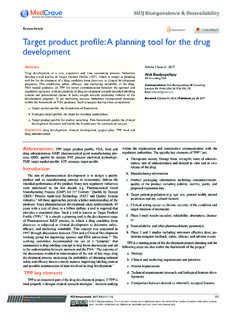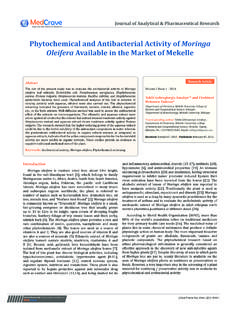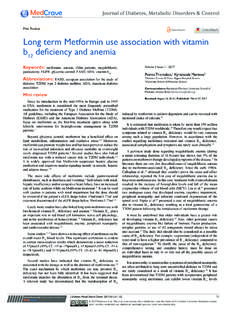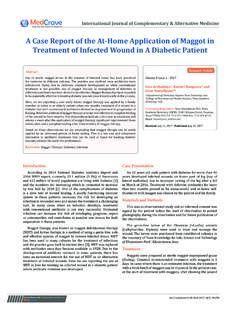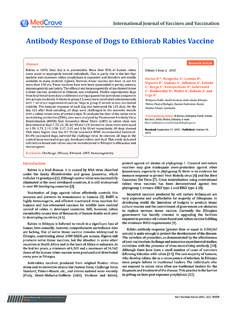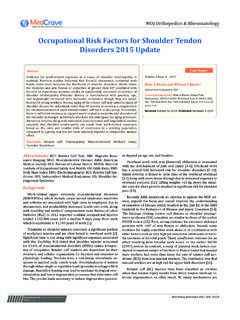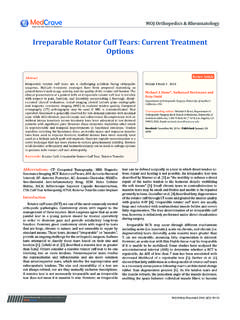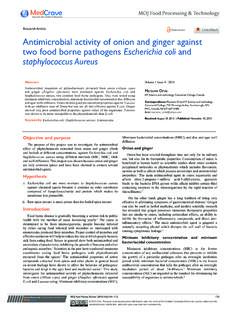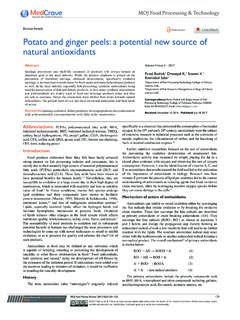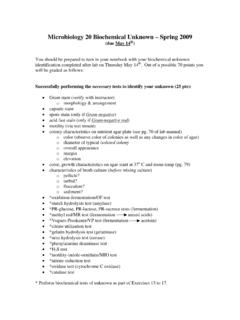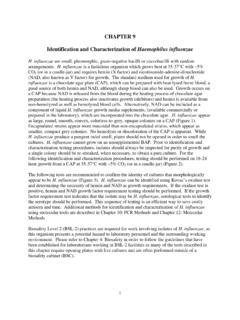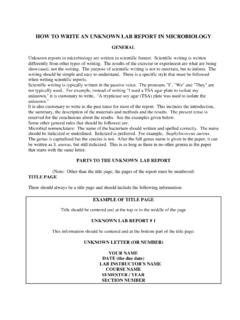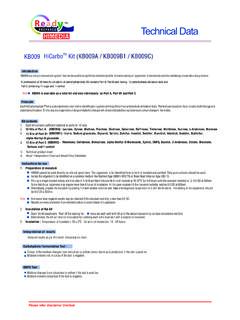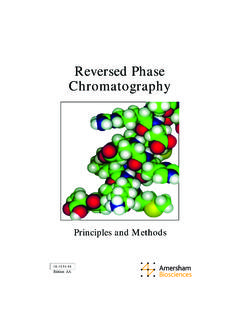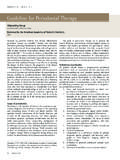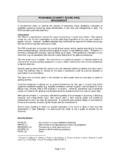Transcription of A review of research on flower-colored mutants of …
1 Submit Manuscript | the important traits that determine the overall value of a flower, color is perhaps the most important. In many flowers, the main component of flower color is anthocyanin, a type of Numerous genes involved in anthocyanin biosynthesis have been analyzed in various plants, and their biosynthesis pathways ,3 In addition to anthocyanins, flavonols and organic acids also play a role in flower color as co-pigments .4 fragrant cyclamen cultivars were previously created using embryo rescue and chromosome doubling to perform interspecific hybridization between Cyclamen purpurascens as the pollen parent and cultivars of C. Initially, the fragrant cyclamen series consisted of purple or pink flowers only and increased variations in flower color were desired.
2 Our overall aim, therefore, is to identify the genes related to cyclamen flower color with the goal of creating different flower-color mutants by using ion-beam irradiation. Here, we summarize the results so far and consider future development of this research . The main component of cyclamen flower color is anthocyanin, with certain flavonols also involved in Approximately 20 homologues of flavonoid biosynthesis-related genes have so far been isolated from C. purpurascens and expression patterns examined by As a result, expression of a number of genes was confirmed in the slip and eye, with lower expression in the leaves. In addition, two flavonol synthase genes (CpurFLS1 and CpurFLS2) were also isolated and detailed analyses performed. As a result, CpurFLS2 is thought to play a role in flower However, further clarification of direct involvement in flower color is required.
3 For example, 3-O-glucosyltransferase (3GT) not only target anthocyanidin, but is also thought to act as a glycosidase of other flavonoids in In the future, clarification of the enzyme genes directly related to flower color is therefore required via comparative analysis using flower- colored mutants and identification of the mutant irradiation technology has been used to create flower- colored mutants of fragrant To do so, ion-beams are used as the physical mutagen rather than gamma rays, x-rays, or neutrons, which are predominantly used for mutation induction in ,12 We previously carried out targeted mutation breeding of flower color using ion-beam irradiation and genomic information,13 and from the original cultivar Koko-no-kaori (KO), which has strong reddish-purple (Royal Horticultural Society Colour Chart; RHS No: N78B)flowers, were able to produce white- (KOpw) and strong purplish-red(RHS No: 71B) flower (KOrp) colors (Figure 1A).
4 Using another cultivar, Kaori-no-mai (KM), which has strong reddish-purple (RHS No: NN78B) flowers, two variants which have deep purplish-red (RHS No: 71A) color in their flower, KMDp and Miyabi-no-mai (MY) were created (Figure 1B). While using a third cultivar Uruwashi-no-kaori (UR) which has light purple (RHS No: 75B) flower-color, Tennyo-no-mai (TN), which has vivid purplish-red (RHS No: 67B) flowers, was created (Figure 1C). Furthermore, we recently created new flower- colored variant from KM (DRP, (Figure 1B). Its flower color is not suit to any colors on RHS Colour Chart (most nearest to RHS No: 59A). Subsequent analysis of flower color components using high-performance liquid chromatography (HPLC) confirmed that the anthocyanin malvidin 3,5-diglucoside (Mv3,5dG) is not present in In contrast, Mv3,5dG was found to be the main flower color component in KOrp, while the presence of flavonols could not be These findings are likely due to mutations in the genes involved in flavonoid biosynthesis.)
5 For example, KOrp is thought to harbor a mutation of the CpurFLS2-like gene from C. purpurascens, and therefore, comparative analysis is currently underway using KO and KOrp. Furthermore, in KMDp, mutation of Mv3,5dG to delphinidin 3,5-diglucoside (Dp3,5dG) was Changes were also observed in MY from Mv3,5G to malvidin 3-glucoside (Mv3dG).14 In contrast, no significant changes to the structure or component ratio of anthocyanins were observed in TN; rather, the content of anthocyanin increased greatly, while that of flavonols These findings suggest that rather than a mutation, flavonoid biosynthesis was activated; or perhaps the negative regulator of the enzyme gene group involved in flavonoid biosynthesis was dominant feature of flower-color mutants created by ion-beam irradiation is their clear genetic background.
6 This is a very important in terms of molecular biological research of horticultural Horticult Int J. 2017;1(3):90 9190 2017 Akita et al. This is an open access article distributed under the terms of the Creative Commons Attribution License, which permits unrestricted use, distribution, and build upon your work review of research on flower- colored mutants of fragrant cyclamens induced by ion-beam irradiationVolume 1 Issue 3 - 2017 Yusuke Akita,1,2 Shiho Morimura,1 Parisa Loetratsami,2 Hiroshi Ishizaka31 Department of Applied Chemistry, Saitama Institute of Technology, Japan2 Department of Life Science and Green Chemistry, Saitama Institute of Technology, Japan3 Saitama Agricultural Technology research Center, JapanCorrespondence: Yusuke Akita, Saitama Institute of Technology, 1690 Fusaiji Fukaya, Saitama, JPN 369-0293, Japan, Tel +81-48-585-6893, Email Received: November 17, 2017 | Published.
7 December 19, 2017 AbstractOrnamental plants are extremely valuable in terms of horticulture and are expected to be in high demand in the future. However, molecular analysis of ornamental plants is very difficult because of the complexity of their genetic backgrounds. To solve this problem, comparative analysis using mutations is a simple and effective approach. In this review , we summarize current molecular research on flower coloration in fragrant wild cyclamen, describing the fragrant cultivars (Cyclamen persicum C. purpurascens) and their flower- colored mutants induced by ion-beam irradiation. These mutants are not only valuable horticultural, but are also useful for molecular analyses of flower coloration in ornamental : anthocyanin, cyclamen, flavonoid, flower color, ion-beam breedingHorticulture International JournalMini ReviewOpen AccessA review of research on flower- colored mutants of fragrant cyclamens induced by ion-beam irradiation91 Copyright: 2017 Akita et : Akita Y, Morimura S, Loetratsami P, et al.
8 A review of research on flower- colored mutants of fragrant cyclamens induced by ion-beam irradiation. Horticult Int J. 2017;1(3):90 91. DOI: with a long cultivation history. For example, KMDp is thought to harbor a mutant of methyltransferase (MT), which functions as an anthocyanin. We therefore isolated four MT genes as candidate mutant factors. Of these, CkmOMT2 was found to function in methylation of delphinidin-derived anthocyanin, playing a direct role in flower This finding could then be easily confirmed thanks to the clear genetic background of KMDp. In the future, our aim is to carry out further comparative analysis using additional ion-beam- induced flower-color mutants in order to confirm the factors involved in flower 1: Flowers of fragrant cyclamens . Koko-no-kaori (KO) and its of interestThe author declares no conflict of Harborne JB, Williams CA.
9 Advances in flavonoid research since 1992. Phytochemistry. 2000;55(6):481 Grotewold E. The genetics and biochemistry of foral pigments. Annu Rev Plant Biol. 2006;57:761 Forkmann G. Flavonoids as Flower pigments: The formation of the natural spectrum and its extension by genetic engineering. Plant Breeding. 1991;106:1 Yazaki Y. Co pigmentation and the color change with age in petals of Fuchsia hybrida. Botanical Magazine. 1976;89(1):45 Ishizaka H. Interspecific hybridization by embryo rescue in the genus Cyclamen. Plant Biotechnology. 2008;25(6):511 Takamura T, Aizawa M, Kim SY, et al. Inheritance of flower color pigment in crosses between cyclamen cultivars and Cyclamen purpurascens. Acta Horticulture. 2005;673:437 Hase Y, Akita Y, Kitamura S, et al. Development of an efficient mutagenesis technique using ion beams: Toward more controlled mutation breeding.
10 Plant Biotechnology. 2012;29(3):193 Akita Y, Kitamura S, Mikami R, et al. Identification of functional flavonol synthase genes from fragrant wild cyclamen (Cyclamen purpurascens). Journal of Plant Biochemistry and Biotechnology. 2018;27(2):147 Sun W, Liang L, Meng X, et al. Biochemical and molecular characterization of a flavonoid 3 O glycosyltransferase responsible for anthocyanins and flavonols biosynthesis in Freesia hybrida. Front Plant Sci. 2016;7 Ishizaka H, Kondo E, Kameari N. Production of novel flower color mutants from the fragrant cyclamen (Cyclamen persicum x C. purpurascens) by ion beam irradiation. Plant Biotechnology. 2012;29:201 Yamaguchi H, Nagatomi S, Morishita T, et al. Mutation induced with ion beam irradiation in rose. Nuclear Instruments and Methods in Physics research Section B.
